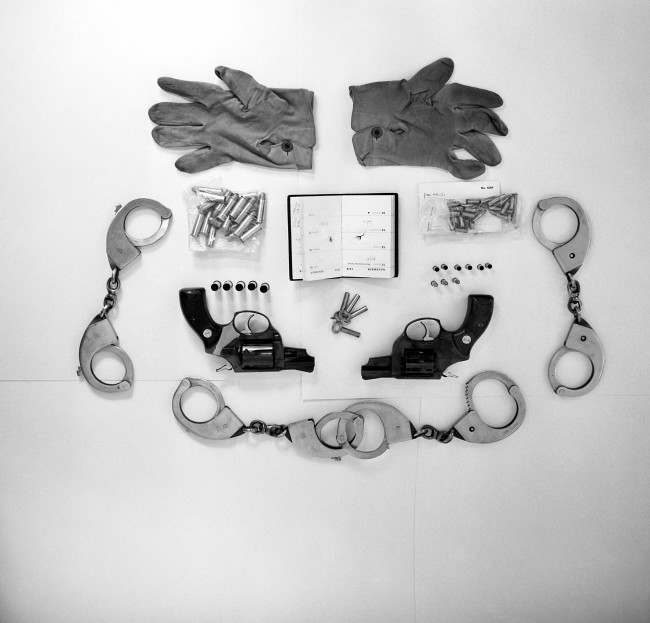
These articles – except the bullet-holed diary – were found by police in the possession of Ian Ball, 26, who pleaded guilty at the Old Bailey to attempting to kidnap Princess Anne, attempted murder of two police officers and wounding two civilians. The diary belonged to shot PC Michael Hills, with the bullet that pierced it still lodged in his liver. On the table are handcuffs, two pairs of which are locked together to provide leg shackles, keys for the handcuffs, gloves worn by Ball during the incident, six spent rounds, three live rounds and 39 spares for the .22 gun and a .38 Astra with five spent rounds and 19 spares. Date: 22/05/1974
ON March 20, 1974, Princess Anne and her husband Captain Mark Phillips were returning to Buckingham Palace along Pall Mall in their Rolls-Royce, driven by Alexander Callender. Rowena Brassey, the Princess’s Lady-in-waiting, was sitting in the car across from the Princess. Next to her was Anne’s armed bodyguard, Inspector James Wallace Beaton.
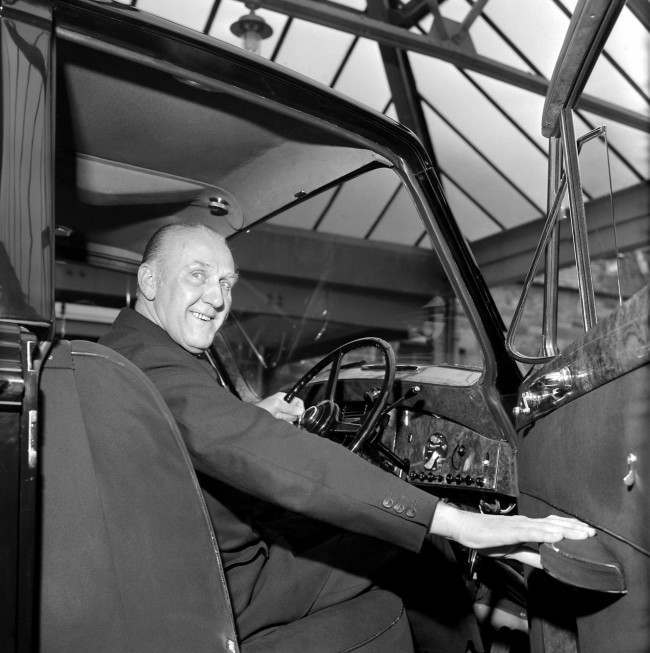
At the wheel of his Royal Rolls Royce in the royal mews of the Palace of Holyroodhouse is Alexander Callender, of Edinburgh, who has been 20 years in the royal service as a chauffeur. He won the Queen’s Gallantry Medal for his part in protecting Princess Anne during the attempted kidnap of Princess Anne by Ian Ball. Date: 05/07/1974
Another car approached. This white Ford Escort forced the Roller to stop by blocking their route. A man got out. He was Ian Ball, 26, an unemployed labourer from north London.
Beaton got of the Rolls.
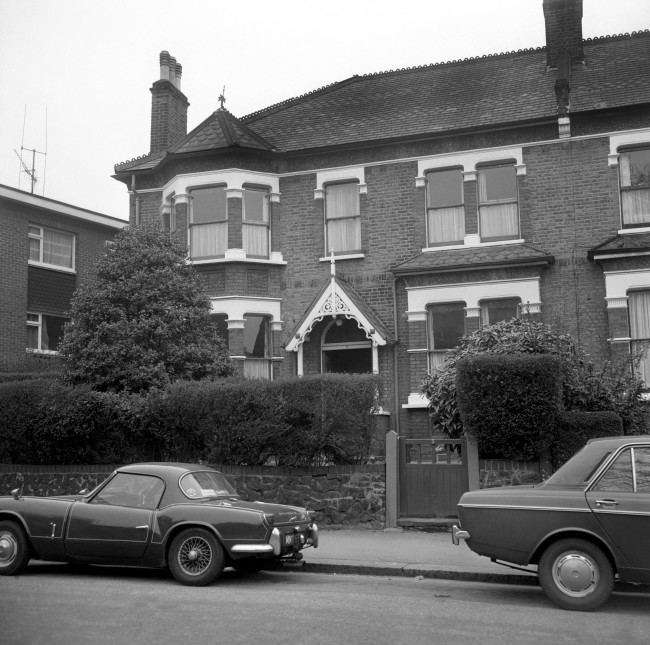
Exterior front view of No.3 Christchurch Road, Crouch Hill, London, which was accommodation used by Ian Ball.
Date: 17/05/1974
He had two guns. He fired six shots at the Princess’s car. He shot Beaton on the shoulder.
Ball then rushed to the Rolls. He tried to open the rear door, where Anne was still seated. Anne and Captain Phillips held it shut. Brassey crawled out the other door. Beaton crawled back in. Ball fired. The bullet hit Beaton’s raised hand. Ball shot Beaton again.
Callendar got our the car. He confronted the gunman. Ball shot him in the chest. Ball now managed to prise open the rear door. He grabbed Anne’s arm. Ball addressed her:
“Please, come out. You’ve got to come.”
Phillips took hold of her. The men pulled. Anne’s dress tore.
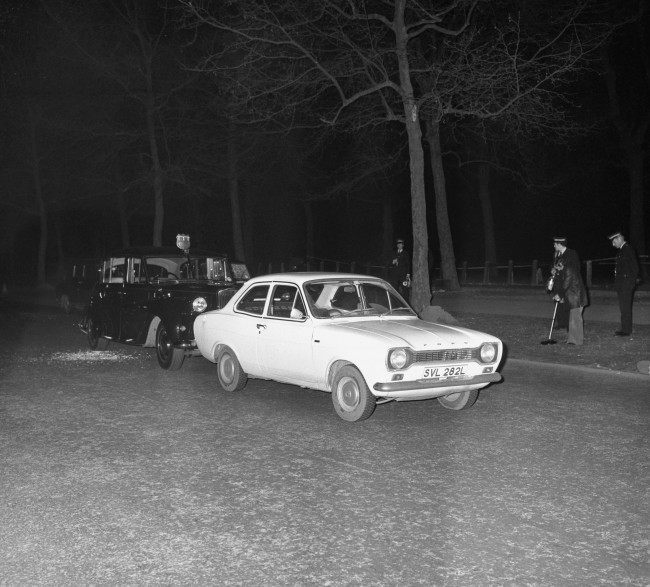
Seven men came to the aide of the Princess.
Among them was tabloid journalist, a former boxer, two chauffeurs and three policemen.
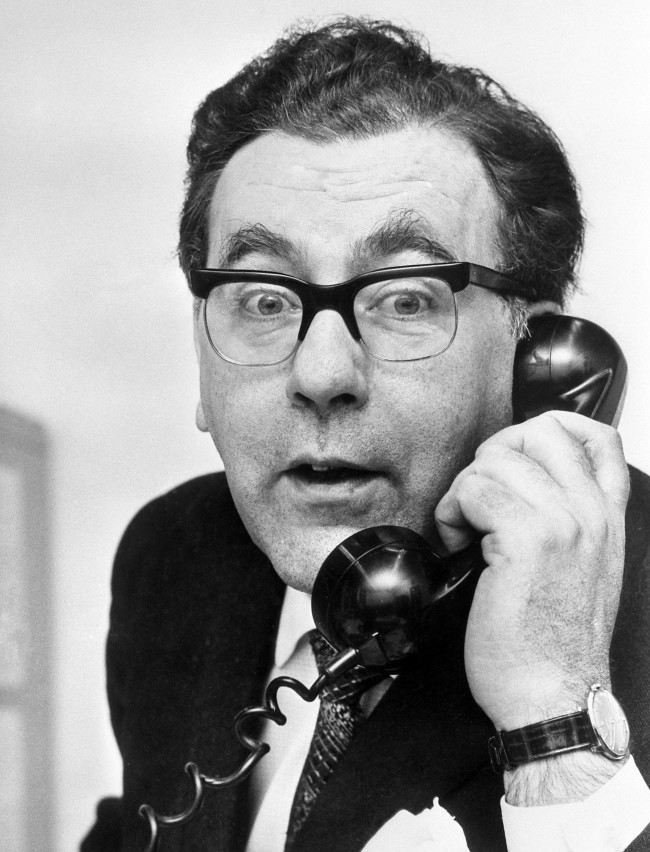
Sun journalist Brian McConnell, 46, was shot in the chest by Ian Ball during the fired by Ian Ball during the attempted kidnap of Princess Anne in Pall Mall. Date: 20/03/1974
PC Michael Hills, 22, heard the shots and attended. He was hit in the stomach. Hills radioed for help.
Ronald Russell, a company cleaning executive, was driving home from work. He saw the commotion. He’d seen Ball shoot Hills. Russell, a 6’4” former boxer, advanced on Ball. Russell would later say:
“I pulled over and heard a lot of banging and smashing which I thought was the general rumpus. But then Ball shot a policeman, and I thought ‘that’s a liberty, he needs sorting’.”
The kidnapping was not going to plan.
A second chauffeur, one Glenmore Martin, now parked his car in front of Ball’s rented car.
Sun journalist John Brian McConnell had been following in a taxi. He got out. He told Ball:
“Don’t be silly, old boy. Put the gun down.”
Ball shot him.
As Ball made once more for the Princess, Russell punched him in the back of the head.
Ball ran around the car towards the princess, she jumped back in with Phillips, shutting the door. Ronald Russell then punched Ball in the face. He said:
“Ball had a gun at her head. I lent in to the car and said ‘come this way Anne, you’ll be safe.’ I pulled her out and held her in front of me. Ball got behind me, and I thought ‘if he shoots me in the back it won’t hurt as much’. I turned and we were face to face. He was pointing a gun at me. I hit him fair and square on the chin. He went down and police were everywhere.”
The place was now swarming with police.
Ball ran.
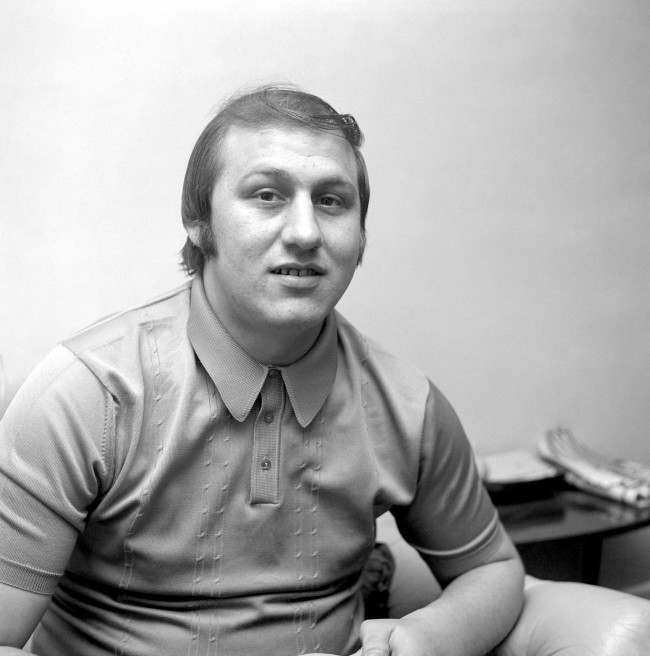
Ron Russell, 28, of Chester Road, Strood, helped Princess Anne during the royal’s attempted kidnapping in Pall Mall.
Ball ran through through St. James Park.
Peter Edmonds, a temporary detective constable, gave chase. He tossed his coat over Ball’s head, rugby tackled him and made an arrest.
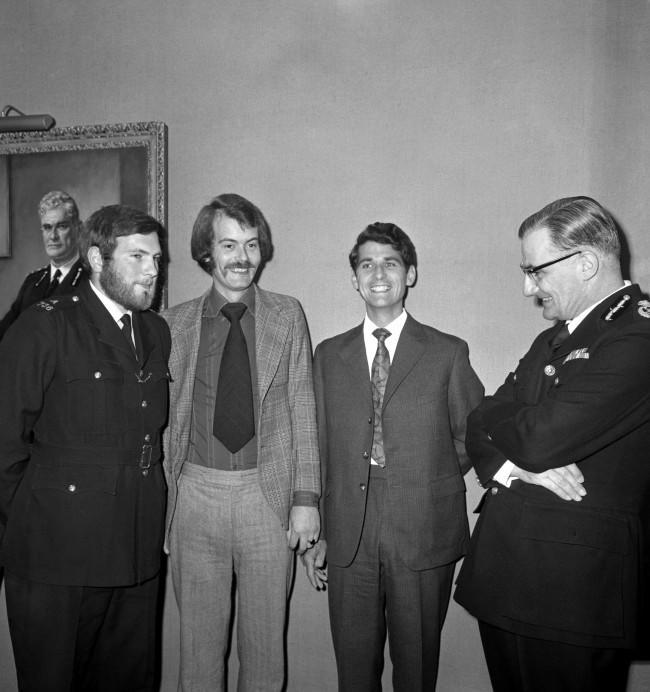
Commissioner of Police for the Metropolis, Sir Robert Mark (r) talks with the three police officers who are to receive bravery awards for protecting Princess Anne during the attempted kidnapping by Ian Ball. (l-r) PC Michael Hills receives the George Medal, Detective Constable Peter Edmonds is awarded the Queen’s Gallantry Medal and Princess Anne’s bodyguard, Inspector James Beaton is awarded the George Cross. Date: 05/07/1974
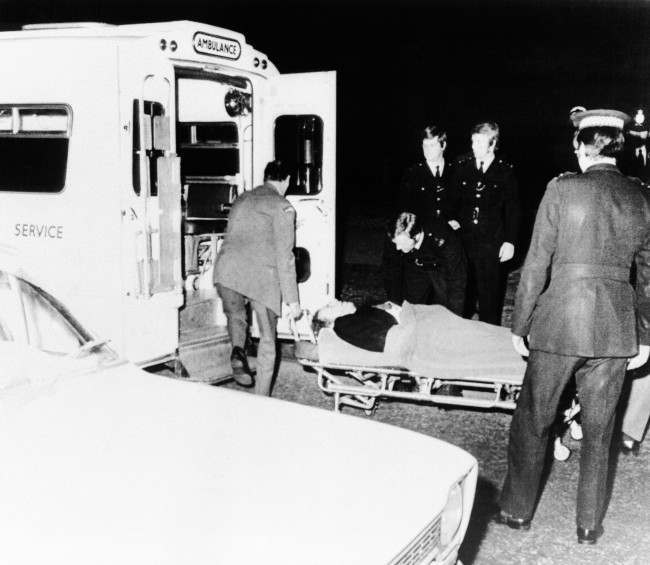
A wounded man is carried into the waiting ambulance

Soon after attempted kidnap of Princess Anne, police officers search among the daffodils blooming at the side of the Mall.
Ball had rented the escort.
When searched, police found the haul you see in the first photograph above: handcuffs, Valium, a ransom letter addressed to the Queen – he would demand £2 million in £5 notes, the money stuffed into 20 unlocked suitcases and sent by plane to Switzerland.

The Royal car in which Princess Anne and Captain Mark Phillips had been travelling in when it was stopped by bullets in a kidnap attempt on the Princess in Pall Mall, London. Date: 20/03/1974
Journalists scrambled to pull together theories on how a mentally ill, unemployed man could have masterminded a well-funded kidnapping attempt on his own. An office clerk told a reporter that the police had traced a typewriter that Ball had rented to write the ransom letter. Papers reported that one line of the letter read “Anne will be shot dead.” Days after the kidnapping attempt, a group calling themselves the Marxist-Leninist Activist Revolutionary Movement sent a letter claiming responsibility to The Times of London. Scotland Yard dismissed any connection between that group and Ian Ball. Others recognized a familiar theme in the reported content of the ransom letter, in which Ball had allegedly stated that he would donate the Queen’s ransom to the National Health Services. One month before, a group identifying as the Symbionese Liberation Army had kidnapped Patricia Hearst. In its communication with the Hearst family, the SLA said that they would return the young woman if her family donated what would amount to millions of dollars of food to hungry Californians.

Princess Anne chats to her wounded bodyguard, Inspector James Beaton at Westminster Hospital. Inspector James Beaton was injured during Ian Ball’s attempt to kidnap Princess Anne in Pall Mall.
Date: 25/03/1974
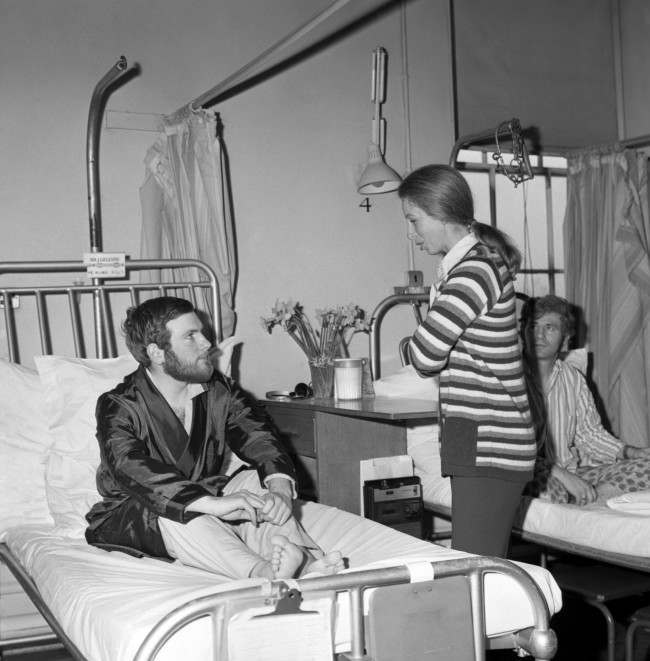
Princess Anne talks to PC Michael Hills, who was injured during Ian Ball’s attempt to kidnap Princess Anne in Pall Mall.
Date: 25/03/1974
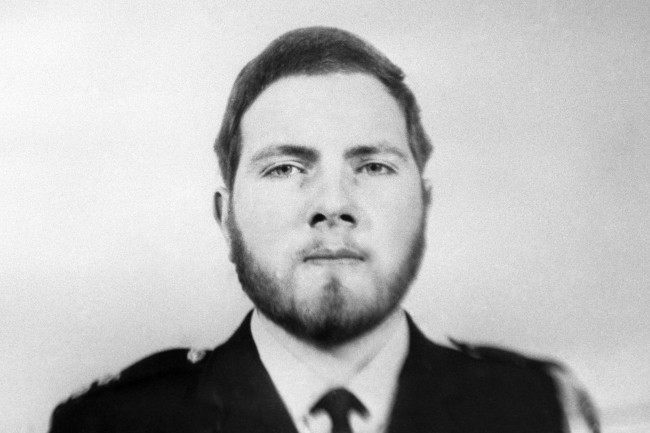
A Scotland Yard picture of Police Constable Michael Hills, a 22-year-old bachelor living at Croydon, Surrey, who was on duty outside St James’s Palace when he heard a gun fire. He was wounded in the chest as he approached gunman Ian Ball and collapsed after using his personal radio to report: “I have been shot”. PC Hills joined the Metropolitan Police ‘A’ Division at Cannon Row last may, straight from training school. Date: 21/03/1974
Ball was tried.

A closed police van, with Ian Ball inside, arrives at Bow Street Court. The unemployed 26-year-old, of no fixed abode, was charged with attempting to murder Princess Anne’s bodyguard, Inspector James Beaton, in Pall Mall.Date: 21/03/1974
Ball told the court:
“I would like to say that I did it because I wished to draw attention to the lack of facilities for treating mental illness under the National Health Service.”
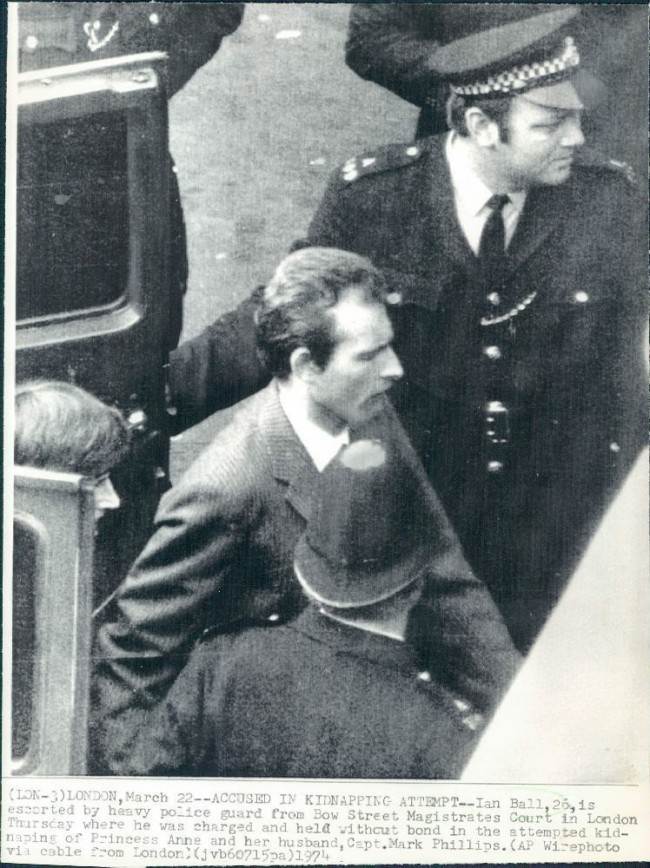
Ball admitted to attempted murder and kidnapping. He was sentenced to a life term in a mental health facility. He would end up in Broadmoor, the high-security psychiatric hospital.
Ball was prosecuted for the attempted murder of the princess’s detective, and various offences under the Offences Against the Person Act, but he was not, perhaps surprisingly, charged with treason; threatening the life of, or kidnapping, the Sovereign’s daughter with the intent of extorting money from the Royal family is not treasonable in the absence of an actual violation.
Ronald Russell was decorated for valour, the Queen pinned the George Cross medal to him and said:
“The medal is from the Queen of England, the thank you is from Anne’s mother.”
Princess Anne seemed fairly cool, telling Michael Parkinson on his TV chatshow:
“It’s fair to say that if anyone was very intent on wiping one out it would be very easy to do.”
Earlier she had said:
“It was all so infuriating; I kept saying I didn’t want to get out of the car, and I was not going to get out of the car. I nearly lost my temper with him, but I knew that if I did, I should hit him and he would shoot me.”
Ian Ball has not been heard of not seen. He is a non-person.
Would you like to support Flashbak?
Please consider making a donation to our site. We don't want to rely on ads to bring you the best of visual culture. You can also support us by signing up to our Mailing List. And you can also follow us on Facebook, Instagram and Twitter. For great art and culture delivered to your door, visit our shop.









